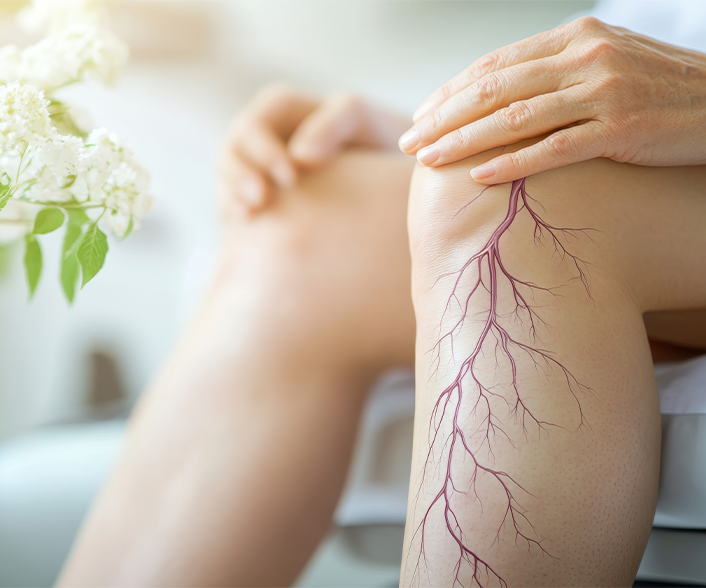Varicose veins are enlarged, swollen, and twisted veins that commonly appear blue or dark purple. Most often, they develop in the legs, either along the inside of the leg or behind the knee. These veins occur when the valves inside the veins are damaged or weakened, causing blood to flow in the wrong direction and pool in the vein. As a result, the veins become enlarged and visible. Many people experience discomfort or cosmetic concerns, and in severe cases, complications can arise.
What Causes Varicose Veins?
According to Dr. Pradeep Muley, an expert in vein treatments, the causes of varicose veins are multifactorial. The most common varicose veins causes include a family history of the condition, pregnancy, aging, obesity, and prolonged periods of standing or sitting. These factors increase pressure in the veins of the legs, leading to valve failure over time. Hormonal changes during pregnancy also play a significant role, as they relax the vein walls, making them more susceptible to becoming varicose. Additionally, jobs that require standing for long hours, such as teaching or factory work, can contribute to developing varicose veins.
Common Symptoms of Varicose Veins
Varicose veins don’t always cause pain but can present several noticeable symptoms. Many people see violet, blue, or skin-colored veins on their legs that appear twisted and bulging. In some cases, varicose veins cause discomfort such as a heavy sensation in the legs, lower leg pain, cramping, burning, swelling, or an itching sensation around the veins. Symptoms often worsen after standing or sitting for long periods. Skin color changes near varicose veins are also common and can indicate a need for medical attention.
When Should You Consult Dr. Pradeep Muley?
It is important to consult a specialist like Dr. Pradeep Muley if you experience persistent pain, swelling, skin ulcers near varicose veins, or signs of bleeding. Early consultation helps in diagnosing the condition accurately and deciding the right course of treatment. A physical examination, detailed medical history, and a duplex ultrasound test (a non-invasive imaging technique that uses sound waves to measure blood flow) are commonly used to confirm the diagnosis of varicose veins.
PEOPLE ALSO LIKE: Which Doctor is Best for Varicose Vein in Delhi?
Effective Treatment Options for Varicose Veins
Self-Care Measures
In the early stages, varicose veins can be managed with simple lifestyle changes. Regular exercise improves circulation, helps maintain a healthy weight, and strengthens the muscles supporting the veins. Elevating the legs while sitting or lying down and avoiding long periods of standing or sitting can help reduce symptoms. Wearing compression stockings is a non-invasive way to support proper blood flow and prevent further vein enlargement.
Medical and Surgical Treatments
When self-care is not enough or the varicose veins become severe, medical procedures are often recommended. Here are some of the effective options offered by Dr. Pradeep Muley:
- Sclerotherapy: A solution is injected into the veins, causing them to collapse and fade.
- Laser Treatment: Uses laser energy to close off varicose veins without surgery.
- Radiofrequency Ablation: A catheter is inserted into the vein, and heat is applied to close it off.
- High Ligation and Vein Stripping: Surgical removal of affected veins.
- Ambulatory Phlebectomy: Small incisions are made to remove superficial varicose veins.
Most of these procedures are performed on an outpatient basis and help patients return to normal activities quickly with minimal discomfort.
How to Prevent Varicose Veins
Prevention plays a vital role in managing varicose veins. Some of the most effective tips include:
- Exercising regularly to improve blood flow and strengthen muscles.
- Maintaining a healthy weight to reduce pressure on veins.
- Avoiding tight clothing that restricts blood flow.
- Not crossing your legs while sitting.
- Quitting smoking to improve circulation.
These simple habits help lower the risk of developing new varicose veins or worsening existing ones.
Frequently Asked Questions (FAQs)
Q1. Are varicose veins dangerous?
Most of the time, varicose veins are not dangerous but can cause discomfort and cosmetic concerns. However, in some cases, they may lead to complications like ulcers, bleeding, or blood clots.
Q2. Can varicose veins disappear on their own?
No, varicose veins usually do not go away by themselves. Proper self-care and medical treatments are needed to manage or remove them.
Q3. Is varicose vein treatment painful?
Most modern treatments, such as laser therapy or sclerotherapy, are minimally invasive and cause only mild discomfort. Doctors like Dr. Pradeep Muley ensure patient comfort during procedures
Q4. How long does it take to recover from varicose vein treatment?
Recovery time depends on the procedure. Many treatments are outpatient and allow patients to return to normal activities within a few days.
Q5. Can varicose veins come back after treatment?
With proper lifestyle habits and follow-up care, the chances of recurrence are low. However, in some cases, new varicose veins may develop over time.
Conclusion – Consult Dr. Pradeep Muley for Expert Care
If you notice symptoms of varicose veins or want to prevent them, don’t wait. Expert care from Dr. Pradeep Muley provides accurate diagnosis and advanced treatment tailored to your needs. Whether it’s non-invasive therapy or minor surgical procedures, help is available.
